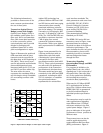
6
Figure 5. Transceiver Relative Optical Power Budget
at Constant BER vs. Signaling Rate.
Figure 6. Bit Error Rate vs. Relative Receiver Input
Optical Power.
illustrates the typical trade-off
between link BER and the
receivers input optical power
level.
Transceiver Jitter
Performance
The Agilent 1300 nm transceivers
are designed to operate per the
system jitter allocations stated in
Table B1 of Annex B of the draft
ANSI T1E1.2 Revision 3 standard.
The Agilent 1300 nm transmitters
will tolerate the worst case input
electrical jitter allowed in Annex
B without violating the worst case
output optical jitter requirements.
The Agilent 1300 nm receivers
will tolerate the worst case input
optical jitter allowed in Annex B
without violating the worst case
output electrical jitter allowed.
Care should be used to avoid
shorting the receiver data or
signal detect outputs directly to
ground without proper current
limiting impedance.
Solder and Wash Process
Compatibility
The transceivers are delivered
with protective process plugs
inserted into the duplex SC or
duplex ST connector receptacle.
This process plug protects the
optical subassemblies during
wave solder and aqueous wash
processing and acts as a dust
cover during shipping.
These transceivers are compatible
with either industry standard
wave or hand solder processes.
Shipping Container
The transceiver is packaged in a
shipping container designed to
The jitter specifications stated in
the following 1300 nm transceiver
specification tables are derived
from the values in Table B1 of
Annex B. They represent the
worst case jitter contribution that
the transceivers are allowed to
make to the overall system jitter
without violating the Annex B
allocation example. In practice,
the typical contribution of the
Agilent transceivers is well below
these maximum allowed amounts.
Recommended Handling
Precautions
Agilent recommends that normal
static precautions be taken in the
handling and assembly of these
transceivers to prevent damage
which may be induced by
electrostatic discharge (ESD).
The HFBR-5200 series of
transceivers meet MIL-STD-883C
Method 3015.4 Class 2 products.
BIT ERROR RATE
-6 4
1 x 10
-2
RELATIVE INPUT OPTICAL POWER – dB
-4 2-2
0
1 x 10
-4
1 x 10
-6
1 x 10
-8
1 x 10
-10
1 x 10
-11
CONDITIONS:
1. 155 MBd
2. PRBS 2
7
-1
3. CENTER OF SYMBOL SAMPLING.
4. T
A
= 25° C
5. V
CC
= 5 V
dc
6. INPUT OPTICAL RISE/FALL TIMES = 1.0/2.1 ns.
1 x 10
-12
1 x 10
-9
1 x 10
-7
1 x 10
-5
1 x 10
-3
CENTER OF SYMBOL
HFBR-5203/5204/5205
SERIES
TRANSCEIVER RELATIVE OPTICAL POWER BUDGET
AT CONSTANT BER (dB)
0 200
0
SIGNAL RATE (MBd)
25 75 100 125
2.5
2.0
1.5
1.0
175
0.5
50 150
CONDITIONS:
1. PRBS 2
7
-1
2. DATA SAMPLED AT CENTER OF DATA SYMBOL.
3. BER = 10
-6
4. T
A
= 25° C
5. V
CC
= 5 V
dc
6. INPUT OPTICAL RISE/FALL TIMES = 1.0/2.1 ns.
0.5


















